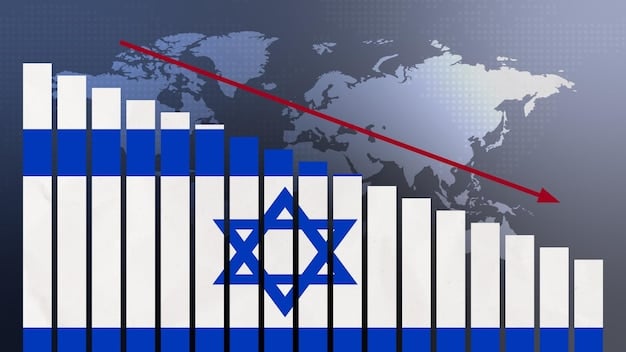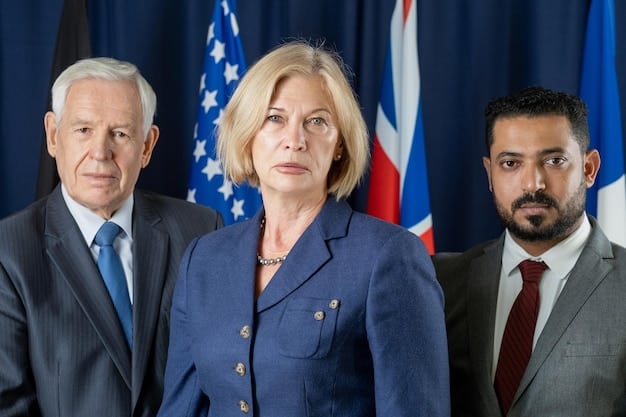US Military Aid to Israel: Impact on Israeli-Palestinian Conflict

US Military Aid to Israel: Analyzing the Impact on the Israeli-Palestinian Conflict explores the complex dynamics of US financial and military support to Israel and its implications on the ongoing conflict, considering factors like regional power balance, human rights concerns, and the prospects for peace.
The US Military Aid to Israel: Analyzing the Impact on the Israeli-Palestinian Conflict is a subject of intense debate and scrutiny. Understanding its implications necessitates a deep dive into historical context, political motivations, and the complex web of relationships shaping the region.
Understanding the Scope of US Military Aid to Israel
The United States has been a consistent provider of military aid to Israel for decades. This support plays a crucial role in Israel’s defense capabilities and regional security strategy. To fully grasp the dynamics, it’s essential to understand the scale and nature of this assistance.
Historical Overview of US Aid
US military aid to Israel began in the 1960s, gradually increasing over the years. It solidified following the Camp David Accords in 1978, evolving into a cornerstone of the US-Israeli strategic partnership.
Current Aid Agreements
The current Memorandum of Understanding (MOU) between the US and Israel, signed in 2016, commits the US to providing $3.8 billion in military aid annually for ten years. This makes Israel the largest recipient of US foreign military financing globally.
- The aid package includes provisions for purchasing advanced US military equipment.
- A portion of the aid allows Israel to spend US dollars in its domestic defense industry.
- This financial support significantly boosts Israel’s military capabilities and its defense industry.
The scale of this aid underscores the strategic importance of the US-Israeli relationship. It also raises questions about its impact on regional stability and the resolution of the Israeli-Palestinian conflict.
The Impact on Regional Power Dynamics
The robust US military aid package has a significant impact on the balance of power in the Middle East. It empowers Israel with advanced military technologies, enhancing its security position but also affecting the broader regional environment.
Military Superiority
US aid enables Israel to maintain a qualitative military edge (QME) over its neighbors. This ensures Israel possesses military capabilities that surpass those of any potential adversary or combination of adversaries in the region.
Deterrence and Security
The aid package contributes to Israel’s deterrence capabilities, discouraging potential attacks. It also provides Israel with resources to respond to threats, thus strengthening its national security.

However, critics argue that this military advantage may contribute to prolonging the conflict by reducing the incentives for negotiation and compromise.
The Effects on the Israeli-Palestinian Conflict
The impact of US military aid on the Israeli-Palestinian conflict is multifaceted and disputed. While proponents argue that it enhances Israel’s security, critics suggest that it perpetuates the occupation and undermines peace efforts.
Security vs. Occupation
Advocates of US aid assert that it provides Israel with the means to defend itself against attacks from Hamas and other militant groups. They argue that a secure Israel is more likely to make concessions for peace.
Human Rights Concerns
Conversely, critics contend that US military aid is used to maintain the occupation of Palestinian territories, contributing to human rights violations. This includes the use of US-supplied weapons in operations that result in civilian casualties.
- Aid may indirectly support settlement construction in the West Bank, considered illegal under international law.
- Human rights organizations have documented numerous cases of misuse of US-supplied weapons.
- Financial aid may free up Israeli domestic funds for settlement expansion and other disputed activities.
The debate over the effects of US aid on the conflict often hinges on differing perspectives regarding security needs, international law, and human rights.
Examining the Motivations Behind US Aid
Understanding the motivations behind US military aid to Israel requires exploring various aspects of US foreign policy, strategic interests, and domestic politics. The support is rooted in a complex interplay of factors.
Strategic Partnership
The US sees Israel as a key strategic ally in a volatile region. Maintaining a strong relationship with Israel supports US interests in countering terrorism, containing Iranian influence, and promoting stability.
Domestic Politics
Strong bipartisan support for Israel exists in the US Congress. This is influenced by lobbying efforts from pro-Israel groups and the significant role of Jewish voters in US elections.

Shared Values and Interests
The US and Israel share democratic values and a commitment to innovation and technological advancement. These shared values serve as a foundation for enduring cooperation.
The combination of strategic interests, domestic political considerations, and shared values forms the basis for the continued provision of US military aid to Israel.
Alternative Perspectives and Policy Recommendations
Considering alternative perspectives on US military aid to Israel and exploring policy recommendations is vital for fostering a more balanced and effective approach. There is a growing call for conditioning US aid to promote human rights and advance peace negotiations.
Conditioning Aid
Some analysts propose conditioning US aid on Israel’s adherence to international law and human rights standards. This would involve linking aid disbursement to specific benchmarks related to the treatment of Palestinians and the cessation of settlement activities.
Increased Oversight
Enhancing oversight mechanisms to ensure US military aid is not used in ways that violate human rights or undermine peace efforts is another recommendation. This could involve stricter monitoring and reporting requirements.
- Independent investigations into alleged uses of US-supplied weapons in human rights abuses.
- Transparency in reporting on the end-use of US aid.
- Dialogue with human rights organizations and civil society groups in the region.
Alternative approaches to US aid seek to address the complex challenges of the Israeli-Palestinian conflict and promote a just and sustainable resolution.
The Future of US Military Aid and the Conflict
The future of US military aid to Israel and its impact on the Israeli-Palestinian conflict remains uncertain. Evolving geopolitical dynamics and shifts in US foreign policy could alter the trajectory of this long-standing relationship.
Changing Geopolitical Landscape
The emergence of new regional powers, shifts in US foreign policy priorities, and evolving security threats could influence the level and nature of US aid to Israel. This includes the Abraham Accords, which have reshaped regional alliances.
Domestic Debates
Growing debate within the US regarding the human rights implications of military aid to Israel may lead to increased scrutiny and potential policy changes. Public opinion and activism are playing an increasingly important role.
The enduring question is whether the aid can be leveraged more effectively to promote a peaceful resolution to the Israeli-Palestinian conflict. This includes supporting confidence-building measures, fostering dialogue, and addressing the underlying causes of the conflict.
| Key Point | Brief Description |
|---|---|
| 🤝 US Aid Commitment | $3.8 billion annually, solidifying a strong alliance. |
| 🛡️ Regional Impact | Maintains Israel’s military edge, affecting regional dynamics. |
| 🕊️ Conflict Effects | Security for Israel vs. prolonged occupation concerns. |
| 🌍 Policy Debates | Calls for conditional aid to promote human rights. |
Frequently Asked Questions
▼
The US currently provides $3.8 billion annually in military aid to Israel under the 2016 Memorandum of Understanding, making Israel the largest recipient of US foreign military financing.
▼
The effects are debated; some see it as enhancing Israeli security, while others view it as perpetuating the occupation and undermining peace efforts due to its contribution to Israel’s military strength.
▼
US motivations include strategic partnership, domestic politics shaped by pro-Israel lobbying, and shared values promoting cooperation in defense and security.
▼
Critics suggest conditioning aid on human rights to promote accountability and encourage peace negotiations rather than enabling actions viewed as hindering resolution.
▼
The future remains uncertain due to shifts in geopolitics and domestic debates, possibly leading to policy changes that require greater oversight and conditionality promoting a just resolution.
Conclusion
Analyzing the impact of US Military Aid to Israel: Analyzing the Impact on the Israeli-Palestinian Conflict reveals a complex and highly contested issue. While the aid bolsters Israel’s security and strategic position, questions persist regarding its effects on the peace process and human rights. Considering alternative perspectives and policy recommendations is vital to fostering a more balanced and effective approach in the future.





